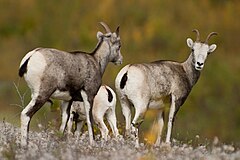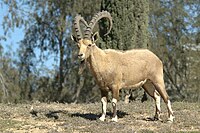Caprinae
| Caprinae Temporal range:
| |
|---|---|

| |
| Scientific classification | |
| Kingdom: | |
| Phylum: | |
| Class: | |
| Order: | |
| Family: | |
| Subfamily: | Caprinae
Gray, 1821 |
| Genera | |
|
Nemorhaedus | |
Subfamily Caprinae is part of the ruminant family Bovidae, consisting of mostly medium-sized bovids. Its members are commonly referred to as goat-antelopes or caprids. The domestic sheep and domestic goat are both part of the goat-antelope group by its widest definition, but some taxonomists[who?] prefer to use the term only for members of the Caprinae that are not members of the tribe Caprini (caprines). The term "goat-antelope" does not mean that these animals are true antelopes: a true antelope is a bovid with a cervid-like or antilocaprid-like morphology.
Characteristics
Although most goat-antelopes are gregarious and have fairly stocky builds, they diverge in many other ways – the muskox (Ovibos moschatus) is adapted to the extreme cold of the tundra; the Rocky Mountain goat (Oreamnos americanus) of North America is specialised for very rugged terrain; the urial (Ovis orientalis) occupies a largely infertile area from Kashmir to Iran, including much desert country. The European mouflon (Ovis musimon) is thought to be the ancestor of the modern domestic sheep (Ovis aries).
Many species have become extinct since the last ice age, probably largely because of human interaction. Of the survivors:
- Five are classified as endangered,
- Eight as vulnerable,
- Seven as of concern and needing conservation measures, but at lower risk, and
- Seven species are secure.
Members of the group vary considerably in size, from just over 1 m (3 ft) long for a full-grown grey goral (Nemorhaedus goral), to almost 2.5 m (8 ft 2 in) long for a musk ox, and from under 30 kg (66 lb) to more than 350 kg (770 lb). Musk oxen in captivity have reached over 650 kg (1,430 lb).
The lifestyles of caprids fall into two broad classes: 'resource-defenders', which are territorial and defend a small, food-rich area against other members of the same species; and 'grazers', which gather together into herds and roam freely over a larger, usually relatively infertile area.
The resource-defenders are the more primitive group: they tend to be smaller in size, dark in colour, males and females fairly alike, have long, tassellated ears, long manes, and dagger-shaped horns. The grazers (sometimes collectively known as tsoan caprids, from the Semitic tso'wn meaning "to migrate") evolved more recently. They tend to be larger, highly social, and rather than mark territory with scent glands, they have highly evolved dominance behaviours. No sharp line divides the groups, but a continuum varies from the serows at one end of the spectrum to sheep, true goats, and musk oxen at the other.
Evolution

The goat-antelope, or caprid, group is known from as early as the Miocene, when members of the group resembled the modern serow in their general body form.[1] The group did not reach its greatest diversity until the recent ice ages, when many of its members became specialised for marginal, often extreme, environments: mountains, deserts, and the subarctic region.
The ancestors of the modern sheep and goats (both rather vague and ill-defined terms) are thought to have moved into mountainous regions – sheep becoming specialised occupants of the foothills and nearby plains, and relying on flight and flocking for defence against predators, and goats adapting to very steep terrain where predators are at a disadvantage.
Extant species
FAMILY BOVIDAE
- Subfamily Caprinae
- Tribe Ovibovini[[[muskox#{{{section}}}|contradictory]]]

Takin (Budorcas taxicolor) 
Spanish ibex (Capra pyrenaica) 
Nubian ibex (Capra nubiana) 
Bharal (Pseudois nayaur) - Tribe Caprini
- Genus Ammotragus
- Barbary sheep, Ammotragus lervia
- Genus Arabitragus
- Arabian tahr, Arabitragus jayakari
- Genus Capra
- West Caucasian tur, Capra caucasica
- East Caucasian tur, Capra caucasica cylindricornis
- Markhor, Capra falconeri
- Wild goat, Capra aegagrus
- Domestic goat, Capra aegagrus hircus
- Alpine ibex, Capra ibex
- Nubian ibex, Capra nubiana
- Spanish ibex, Capra pyrenaica
- Siberian ibex, Capra sibirica
- Walia ibex, Capra walie
- West Caucasian tur, Capra caucasica
- Genus Hemitragus
- Himalayan tahr, Hemitragus jemlahicus
- Genus Ovis
- Argali, Ovis ammon
- Domestic sheep, Ovis aries
- American bighorn sheep, Ovis canadensis
- Dall or thinhorn sheep, Ovis dalli
- European mouflon, Ovis musimon
- Snow sheep, Ovis nivicola
- Wild sheep, Ovis orientalis
- Genus Nilgiritragus
- Nilgiri tahr, Nilgiritragus hylocrius
- Genus Pseudois
- Bharal (Himalayan blue sheep), Pseudois nayaur
- Dwarf blue sheep, Pseudois schaeferi
- Genus Ammotragus
- Tribe Naemorhedini

Grey goral (Nemorhaedus goral) - Genus Capricornis
- Japanese serow, Capricornis crispus
- Sumatran serow, Capricornis sumatraensis
- Taiwan serow, Capricornis swinhoei
- Chinese serow, Capricornis milneedwardsii
- Red serow, Capricornis rubidus
- Himalayan serow Capricornis thar
- Genus Nemorhaedus
- Red goral, Nemorhaedus baileyi
- Chinese goral, Nemorhaedus griseus
- Grey goral, Nemorhaedus goral
- Long-tailed goral, Naemorhedus caudatus
- Genus Oreamnos
- Mountain goat, Oreamnos americanus
- Genus Rupicapra
- Pyrenean chamois, Rupicapra pyrenaica
- Chamois, Rupicapra rupicapra
- Genus Capricornis
- Tribe Ovibovini[[[muskox#{{{section}}}|contradictory]]]
Fossil genera
The following extinct genera of Caprinae have been identified:[2][3]
- Tribe Ovibovini
- Genus Bootherium †
- Bootherium bombifrons †
- Genus Euceratherium †
- Euceratherium collinum †
- Genus Makapania †
- Makapania broomi †
- Genus Soergelia †
- Soergelia mayfieldi †
- Genus Tsaidamotherium †
- Tsaidamotherium brevirostrum †
- Tsaidamotherium hedini †
- Genus Bootherium †
- Tribe Caprini
Unsorted
- †Benicerus
- †Boopsis
- †Capraoryx
- †Caprotragoides
- †Criotherium
- †Damalavus
- †Gallogoral
- †Lyrocerus
- †Megalovis
- †Mesembriacerus
- †Neotragocerus
- †Nesogoral
- †Norbertia
- †Numidocapra
- †Oioceros
- †Olonbulukia
- †Pachygazella
- †Pachytragus
- †Palaeoreas
- †Palaeoryx
- †Paraprotoryx
- †Parapseudotragus
- †Parurmiatherium
- †Praeovibos
- †Procamptoceras
- †Prosinotragus
- †Protoryx
- †Pseudotragus
- †Samotragus
- †Sinocapra
- †Sinomegoceros
- †Sinopalaeoceros
- †Sinotragus
- †Sivacapra
- †Sporadotragus
- †Symbos
- †Tethytragus
- †Tossunnoria
- †Turcocerus
- †Urmiatherium
References
This article needs additional citations for verification. (October 2015) |
- ^ Geist, Valerius (1984). Macdonald, D. (ed.). The Encyclopedia of Mammals. New York: Facts on File. pp. 584–587. ISBN 0-87196-871-1.
- ^ tolweb.org
- ^ palaeos.org





